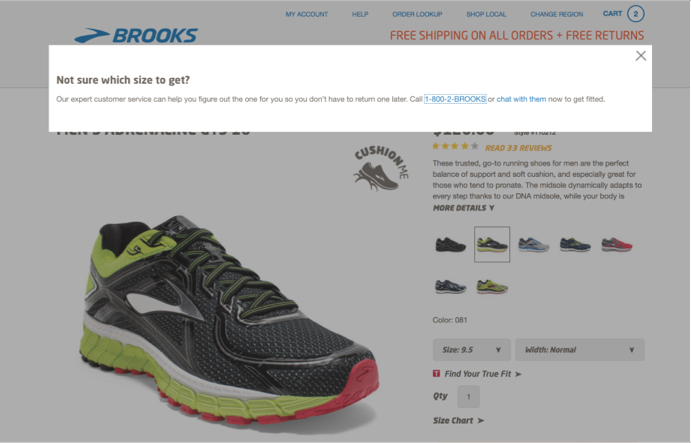Brooks Running opplever 80 % nedgang i returprosent
Brooks Running reduserer returfrekvensen
For forhandlere handler ikke optimalisering bare om å øke konverteringsfrekvensen eller den gjennomsnittlige ordreverdien; faktisk har mange forhandlere innsett at optimalisering for mer enn konverteringsfrekvens og AOV vil være avgjørende for å vinne i netthandel.
Ta for eksempel Brooks Running. Løpeselskapet undersøkte nylig kjøpsmønsteret til kunder som returnerte varer, og testet hvordan de kunne forbedre kundetilfredsheten og inntektene ved å forutse og forhindre retur av sko.
Hvorfor fokusere på returer og ikke konverteringsfrekvens? Fordi returer koster - både tid, penger og muligheter for både bedriften og kunden.
Det kan ta flere uker før kunden sender returen, Brooks bearbeider SKU-ene på nytt og fyller opp hyllene. I tillegg er retur dårlig for den generelle kundeopplevelsen, og en vare som returneres, betyr at andre kunder som ønsker å kjøpe en vare, kan få meldinger om at den er utsolgt når varen de ønsket seg, er på vei gjennom bytteprosessen. Ingen liker returer. Selv om de er gratis, er returer en plage for kundene og tærer på forhandlernes marginer.
Så hvordan skaper du en opplevelse som kundene er fornøyde med, og som gjør det mindre sannsynlig at de returnerer? Brooks fant ut at det er en kombinasjon av å forstå den unike vurderingssyklusen for hvert produkt, spore de riktige dataene og bruke Optimizely til å gi en målrettet opplevelse til det rette kundesegmentet.
De skjulte kostnadene ved store bestillinger
Brooks-teamet begynte med å se nærmere på bestillinger med høy verdi. Ved første øyekast er en høy gjennomsnittlig ordreverdi en god ting, og mange forhandlere streber etter å øke dette måltallet. Men en høy verdi på feil produkter kan være problematisk.
Teamet så et mønster i disse store bestillingene: Mange av dem gjaldt sko av samme modell, bare en halv størrelse eller bredde fra hverandre. Ved å undersøke dataene så teamet at når noen kjøper to eller flere par sko med bare en halv størrelses- eller breddeforskjell, vil minst ett av parene statistisk sett bli returnert. Kunden er faktisk på jakt etter den beste passformen. I dette tilfellet er høy AOV ikke en god ting.
"Et betydelig antall av skokjøpene våre gjelder samme modell, men innenfor en bredde eller en halv størrelse fra hverandre", sier David Kornfield, markedssjef med ansvar for optimalisering og analyse hos Brooks Running. "Vi vet med nesten 100 % sikkerhet at ett av disse parene vil komme tilbake."
Teamet visste hvor kostbare returer er, og fokuserte derfor på å redusere antallet returer for disse bestillingene.
Den virkelige opplevelsen på nettet
Da teamet vurderte utfordringen med å redusere returprosenten i segmentet av kunder som kjøper lignende størrelser av samme sko, hentet de inspirasjon fra butikkopplevelsen. Hva gjør du når du trenger hjelp med å finne størrelsen? Du snakker med en butikkmedarbeider. Så de bestemte seg for å ta med seg den virkelige opplevelsen på nettet.

Brooks viste denne popup-meldingen til kunder som hadde to eller flere par sko i handlekurven som var en halv størrelse fra hverandre.
Brooks-teamet brukte Optimizely for å løse denne utfordringen. De skapte en målgruppe av kunder som oppfylte disse kriteriene: 2 eller flere par sko i handlekurven med en halv størrelse fra hverandre. De lagde en spesiell popup-melding for dette segmentet som lød: "Er du usikker på hvilken størrelse du skal velge? Vår dyktige kundeservice kan hjelpe deg med å finne ut hvilken størrelse som passer deg, slik at du slipper å returnere en senere. Ring 1-800-2-BROOKS eller chatte med dem nå for å finne riktig størrelse.
Resultater
Kampanjen fungerte utrolig bra. For testsegmentet gikk returraten ned med nesten 80 %. Ikke bare hadde Brooks flere produkter på lager, men kundene satte også pris på den personlige kontakten. 88 % sa at de satte pris på kundeservicetilbudet om å hjelpe.
Konverteringsraten økte med 2 %, noe teamet mener skyldes mindre "webrooming" - når kunder ser på produkter på nettet og deretter velger å kjøpe dem i en fysisk butikk - siden kundeservicemedarbeiderne kunne ta opp størrelsesproblemer på forhånd. I tråd med forventningene gikk AOV ned, men likevel økte antall kjøp av tilleggsprodukter, kanskje fordi kundene ikke trengte å vente på returkreditt for å fullføre samlingen av løpeutstyr.
Brooks målte også kostnaden for kundeservicetid - er det dyrere å ha mennesker til å svare på kundenes spørsmål enn kostnadene ved retur? De fant ut at svaret var nei. I gjennomsnitt tok kundeservicen fem minutter, noe som var billigere enn de harde kostnadene ved oppfyllelse og returfrakt for hver returnerte ordre.
"I stedet for å akseptere returraten som en konstant, kunne vi utfordre den allment aksepterte raten og omdisponere pengene som var budsjettert til returer, til å finansiere nye programmer og initiativer", legger Kornfield til.
Som et resultat av denne kampanjen:
- Kundene er fornøyde med å vite at Brooks-teamet er der for å hjelpe til med kundeservice
- Kundene trenger ikke å bruke tid på returer
- Flere produkter er tilgjengelige for salg til andre
For Brooks betyr optimalisering utover konverteringsfrekvensen at man fokuserer på kundeopplevelsen for å beskytte bunnlinjen. Det er et skifte fra A/B-testing til personaliserte opplevelser for ulike kundesegmenter.
"Etter å ha tatt tak i grunnleggende forbedringer av nettstedet, blir A/B-testing mindre av en bredspektret taktikk og mer fokusert på brukernivå og atferdsforhold", sier Kornfield. "Du må grave i ytelsesdataene dine og ta tak i spesifikke behov hos kundekohorter."
Lærdom å ta med seg
- Optimaliser for en helhetlig opplevelse, ikke bare klikk
- Identifiser et meningsfylt segment, forstå atferden deres ved å spørre: Hvem er kundesegmentene mine? Hva prøver de å gjøre? Hvor kommer opplevelsen til kort?
- Målrett en sanntidsintervensjon, og som alltid må du måle effekten

